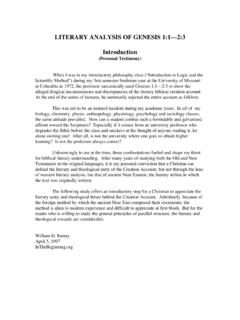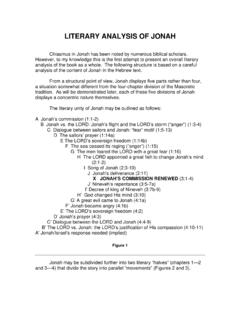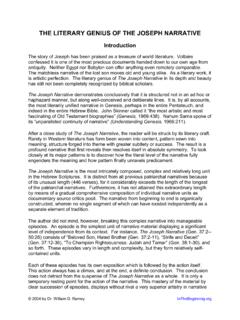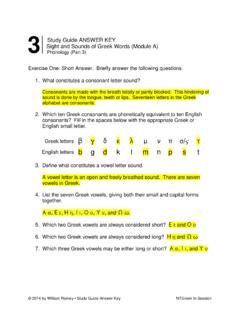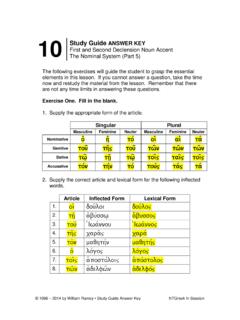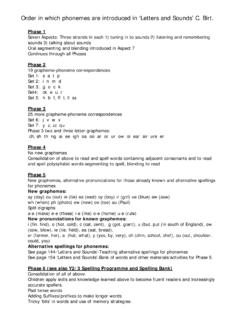Transcription of 1 The Greek Alphabet
1 1 the greek alphabet Sight and Sounds of the Greek Letters (Module A) The Letters and Pronunciation of the Greek Alphabet Phonology (Part 1) Overview Introduction, 1- 1 the greek alphabet , 1-2 Greek Small Letters, 1-13 Greek Capital Letters, 1-15 The Greek Alphabet Charted, 1-16 Further Information, 1-17 Study Guide, 1-19 Introduction Learning to write the Greek letters and how to pronounce them is introduced in this lesson. Mastering the sight and sounds of the Alphabet lays the cornerstone for learning the sight and sounds of Greek words in all subsequent lessons. Your first step toward learning NTGreek is to memorize the Greek alphabetical characters and the order in which they occur in the Alphabet .
2 You are sowing the seed for future failure if you do not thoroughly learn them! The Greek Alphabet has twenty-four letters. Each letter is represented by both a small and capital letter . The difference between the small and capital letters is no different from the small and capital letters in English. Seven alphabetical letters are vowels, and the remaining seventeen letters are consonants. It is vital to learn the names of these letters, correctly to write both the small and capital letters, and the proper pronunciation of each alphabetical character. This will not be as difficult as expected, since many English and Greek alphabetical characters are very similar.
3 The types of Greek letters in the Alphabet . Two major types of speech sounds constitute the Greek Alphabet as with the English Alphabet . The open sounds with free breath are the vowel letters, and the closed sounds with restricted breath are the consonant letters. 2014 by William Ramey Phonology (Part 1) NTGreek In Session LESSON 1: The Greek Alphabet 1-2 Sight and Sounds of the Greek Letters (Module A) _____ When one says ah for the doctor, an open sound is made with free passage of breath. The sound may be made as long as there is breath.
4 This sound is a vowel, as are all the other open and freely breathed sounds in speech. The various vowel sounds are enunciated by modification of the shape of the oral chamber, and by movements of the tongue and lips. There are seven vowel letters in the Greek Alphabet . The open quality of vowels distinguishes them from another type of letter , the consonant. Simply stated, a consonant is any single letter that is not a vowel. The consonant letters are pronounced with the breath totally or partly blocked. This hindering of sound is done by the tongue, teeth, or lips. There are seventeen consonant letters in the Greek Alphabet . The Greek alphabetical letters and sounds.
5 A sound sufficiently distinct from other sounds as to differentiate meaning is a phoneme. Each phoneme is represented in writing by a unique alphabetical letter . For example, the words pat and bat have different meanings because the two consonant letters p and b are separate phonemes . Although the forming of these two letters by the lips is identical, the vocal cords are used with b but not with p . A word s phonetic pronunciation is produced by the quick succession of its individual letter phonemes . In bat , the combined sound of each alphabetical letter ( b + a + t ) yields the word s total phonetic sound. However, only context determines the meaning of the word ( , bat as a stout wooden stick or club; bat as a nocturnal flying mammal; or bat as to move the eyelids quickly).
6 This lesson introduces each Greek alphabetical character s phoneme, as well as the pronunciation of each Greek alphabetical letter . The Greek Alphabet The approach in learning the Greek Alphabet is first by seeing the individual capital and small letter , then correctly pronouncing and correctly writing them in their alphabetical order. Memorizing them in this order from the beginning will pr ove helpful later when using a Greek -English lexicon. A lexicon is more than a dictionary, for it also cites actual usages of a word within a document(s). The term phoneme is pronounced as f n m. The twenty-four Greek alphabetical characters represent twenty-four different phonemes .
7 2014 by William Ramey Phonology (Part 1) NTGreek In Session LESSON 1: The Greek Alphabet 1-3 Sight and Sounds of the Greek Letters (Module A) _____ The suggested procedure for learning the Alphabet is straightforward. Use the provided practice Greek Alphabet practice pages on pages 1-19 through 1-24. Proper penmanship while learning to write the Greek letters is an essential step in learning Greek . Possible confusion between the letters is avoided from the start if bad habits are not learned! Next, use the animated tutorial link below each Greek alphabetical letter to learn how properly to form the character and how its phoneme and alphabetical character is pronounced.
8 On your practice sheets, practice writing both the capital and small Greek letters while listening to the letter s pronunciation. As you listen to how an alphabetical character is pronounced, remember that the pronunciation of a letter s phoneme is learned by proper pronunciation of its alphabetical name. For example, the second letter in the Greek Alphabet is , and is pronounced as the first letter in its alphabetical name, (b ta). Knowing how to pronounce the character s alphabetical name, therefore, is to know how to pronounce the Greek letter s phoneme. This is also true for all the remaining letters in the Alphabet . A Greek letter s phoneme has the same pronunciation as does its initial sound of its alphabetical letter s name.
9 As stated before, the twenty-four letters of the Greek Alphabet are divided into two types: seven are vowels and the remaining seventeen are consonants. Beginning on page 1-5, the order does not reflect these separate categories, but rather the Greek letters proper alphabetical order. Moreover, each of the twenty-four Greek letters is represented by two forms. The first letter illustrates the capital letter (or upper case), and then its corresponding small letter (or lower case) follows. The capital letters should be studied along with their matching small letters. The letters should be pronounced aloud several times while practicing writing them. The human eye must not carry the entire burden of learning and memorizing the alphabetical order of the Greek Alphabet .
10 The arrow accompanying each case letter indicates the starting point and direction of flow when forming a Greek character. Greek is read from left to right like English. Therefore if at all possible a Greek letter should be written so that the final stroke ends to the furthest right where the next letter s stroke begins. The Greek names for the lower case letters are spelled on the following pages with accompanying accents and breathing marks. Whereas these are for future A Greek letter s phoneme has the same pronunciation as does the opening sound of its alphabetical letter s name. 2014 by William Ramey Phonology (Part 1) NTGreek In Session LESSON 1: The Greek Alphabet 1-4 Sight and Sounds of the Greek Letters (Module A) _____ reference they may be disregarded for the time being.
